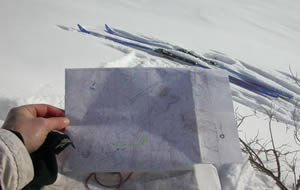
 |
|
|
The wandering of the magnetic north poleOctober 29, 2007By Ned Rozell 
Magnetic north changes all the time because of forces within the Earth. Ned Rozell photo. There, his compass needle dipped like a divining rod over water. "I had to tilt the compass quite a bit to keep the needle from hitting the face," said Siglin, whose snowmachine odysseys have taken him thousands of miles in the high Arctic. The magnetic north pole is now somewhere centered on the Arctic Ocean north of Canada, approximately latitude 82 degrees north and longitude 114 degrees west. It won't be there long. The magnetic pole migrates about 10 kilometers northwest each year. Scientists at the U.S. Geological Survey say the magnetic north pole has strayed around the north for thousands of years, at one point dropping to the latitude of Anchorage. Within Earth is a core that resembles a ball of molten iron and nickel slightly smaller than the moon. When the core rotates, the sloshing of molten iron and nickel produces an electric current, and with it a magnetic force. Ground zero for this force is the elusive spot known as the magnetic north pole. In 1600, Sir William Gilbert, a doctor for Queen Elizabeth I, was the first to suggest Earth behaved like a giant magnet. In 1829, Sir John Ross commanded an expedition to find the North West Passage from the Atlantic to the Pacific. He didn't make it. Ice trapped his ship in Canada's Arctic for four years. Before the ships were able to retreat to England, Ross's nephew, James Ross, discovered the magnetic north pole. When Norwegian Roald Amundsen found the same point during the first successful trip through the Northwest Passage 70 years later, magnetic north was 30 miles north of where Ross found it. Amundsen's journey proved that the magnetic north pole moves. Scientists still aren't sure why it moves, or even why the Earth is similar to a giant bar magnet. The magnetic north pole isn't the same as the geographic north pole, the center of Earth's axis. The discrepancy makes topographic maps a bit more confusing, requiring compass users to adjust for declination, the difference between geographic (true) north and magnetic north. Because the magnetic north pole is always changing, USGS updates its maps every five years. Most handheld GPS units adjust themselves automatically for declination, which varies wildly with location. In Fairbanks, for example, magnetic north is about 21 degrees east of true north. New York City is about 13 degrees west. On the island of Attu in the Aleutians, quirks in Earth's magnetic field make adjusting a compass for declination unnecessary-true north there is the same as magnetic north. The magnetic north pole's constant movement assures the truthfulness of what James Ross wrote upon first discovering its location 173 years ago: "Nature had erected no monument to denote the spot which she had chosen as the center of one of her great and dark powers." © AlaskaReport News This column is provided as a public service by the Geophysical Institute, University of Alaska Fairbanks, in cooperation with the UAF research community. Ned Rozell is a science writer at the institute. |